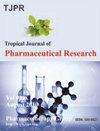Biological activity and mechanism of action of Gotu kola oil in skin wound repair
IF 0.6
4区 医学
Q4 PHARMACOLOGY & PHARMACY
引用次数: 0
Abstract
Purpose: To investigate the biological activity and mechanism of action of Gotu Kola oil in skin wound repair. Methods: In this study, a total of 40 Sprague-Dawley (SD) rats were meticulously chosen to establish a skin wound model. The rats were randomly allocated to a study group, which received topical application of Gotu kola oil, and control group, which served as the model control. Each group consisted of 20 rats to ensure an adequate sample size. The wound area was measured using precise digital imaging software to quantitatively determine the rate of wound healing. Expression levels of hepatocyte growth factor (HGF), vascular endothelial growth factor (VEGF) and transforming growth factor-beta 1 (TGF-β1) were determined by quantitative reverse transcription-polymerase chain reaction (qRT-PCR) while the extent of microvassel regeneration at the wound site was determined by immunohistochemical method using CD34 as a marker. Results: The wound healing rate in the study group was higher than in the control group. In the study group, the transcription levels of HGF and VEGF were higher than in the control group on days 3, 7, and 14, while the transcription level of TGF-β1 was higher on days 7 and 14. Microvessel density (MVD) in the study group was higher than in the control group on days 3 and 7 (p < 0.05). Conclusion: Gotu kola oil facilitates wound healing by promoting the generation of capillaries at the wound site. Harnessing this potential of Gotu kola oil may lead to the development of more efficacious treatment strategies for skin wound repair, ultimately enhancing the quality of life of the patients.哥度柯拉油在皮肤伤口修复中的生物活性和作用机制
目的:研究哥度柯拉油在皮肤伤口修复中的生物活性和作用机制。研究方法:本研究精心挑选了 40 只 Sprague-Dawley (SD) 大鼠建立皮肤伤口模型。大鼠被随机分配为研究组和对照组,研究组大鼠局部涂抹哥度柯拉油,对照组大鼠作为模型对照。每组 20 只大鼠,以确保足够的样本量。使用精确的数字成像软件测量伤口面积,以定量确定伤口愈合率。采用定量反转录聚合酶链反应(qRT-PCR)测定肝细胞生长因子(HGF)、血管内皮生长因子(VEGF)和转化生长因子-β1(TGF-β1)的表达水平,并以 CD34 为标记物,采用免疫组化方法测定伤口处微囊再生的程度。结果研究组的伤口愈合率高于对照组。研究组的 HGF 和 VEGF 在第 3、7 和 14 天的转录水平高于对照组,而 TGF-β1 在第 7 和 14 天的转录水平高于对照组。研究组的微血管密度(MVD)在第 3 天和第 7 天高于对照组(P < 0.05)。结论哥度柯拉油通过促进伤口处毛细血管的生成来促进伤口愈合。利用哥度柯拉油的这一潜力,可以开发出更有效的皮肤伤口修复治疗策略,最终提高患者的生活质量。
本文章由计算机程序翻译,如有差异,请以英文原文为准。
求助全文
约1分钟内获得全文
求助全文
来源期刊
CiteScore
1.00
自引率
33.30%
发文量
490
审稿时长
4-8 weeks
期刊介绍:
We seek to encourage pharmaceutical and allied research of tropical and international relevance and to foster multidisciplinary research and collaboration among scientists, the pharmaceutical industry and the healthcare professionals.
We publish articles in pharmaceutical sciences and related disciplines (including biotechnology, cell and molecular biology, drug utilization including adverse drug events, medical and other life sciences, and related engineering fields). Although primarily devoted to original research papers, we welcome reviews on current topics of special interest and relevance.

 求助内容:
求助内容: 应助结果提醒方式:
应助结果提醒方式:


